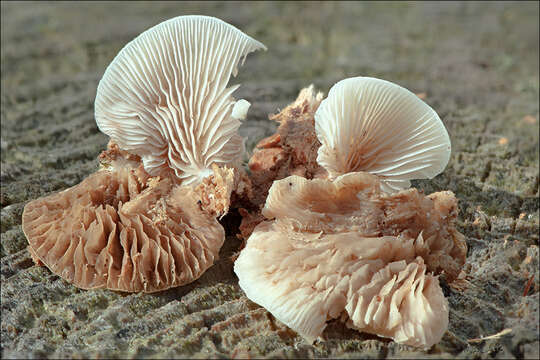Crepidotus_applanatus_4

Description:
Crepidotus applanatus (Pers.) P. Kumm., syn.: Crepidotus applanatus var. subglobiger Singer, Crepidotus applanatus var. globiger (Berk.) Pilt, Crepidotus globiger (Berk.) Sacc., Agaricus globiger Berk., Crepidotus putrigenus (Berk. & M.A. Curtis) Sacc.,Family: InocybaceaeEN: Flat Oysterling, Flat Crep DE: Abgeflachtes Stummelfchen, Gerieftes Stummelfchen, Geriefter KrppelfuSlo.: sploena postranicaDat.: Nov. 1. 2022Lat.: 46.35999 Long.: 13.70434Code: Bot_1495/2022_DSC9266Habitat: grassland; open, locally nearly flat terrain; calcareous, colluvial, skeletal ground, partly sunny; exposed to direct rain, average precipitations ~ 3.000 mm/year, average temperature 7-9 deg C, elevation 568 (1.860 feet), alpine phytogeographical region (according to M. Wraber, 1969).Substratum: rotten, partly moss covered stump of Picea abies. Place: Lower Trenta valley, right bank of river Soa; between villages Soa and Trenta; near Skokar, Trenta 2 abandoned farm house, East Julian Alps, Posoje, Slovenia EC. Comments (pertain to pictures in the Flickr album Crepidotus applanatus): Crepidotus applanatus is one of several tens of small, whitish, pleurotoid fungi growing on decaying wood. Breitenbach (Ref.6) claims that they are nearly indistinguishable in the field based on morphological traits only. Microscopy seems to be a must for proper determination. Fortunately, Crepidotus applanatus has quite characteristic spores. They are sub-globose and spiny. Their diameter is usually about 5-6 . Many sources claim as possible substratum hardwood only. Yet, some claim conifers wood too (Ref. 2, Ref. 3). This find seems to be such an exception. Such finds have been described in the literate as Crepidotus applanatus var. subglobiger. This variant has a little longer spores than those growing on hardwood and slightly different shape of cheilocystidia. nevertheless. Index Fungorum synonymizes this variety with Crepidotus applanatus.The pilei width was up to 3.5 cm and they stretch up to 3 cm away of the substratum, there was no stipe; flesh was hydrophanous, soft and very brittle; taste mild, smell indistinguishable; fungus apparently causing brown rot; SP abundant, deep ochre-brown, oac797.Spores are sub-globose to globose and distinctly verrucose. Dimensions: (5.2) 5.5 - 6.2 (6.6) (5.1) 5.2 - 6 (6.3) m; Q = 1 - 1.09 (1.1); N = 40; Me = 5.8 5.6 m; Qe = 1; Olympus CH20, NEA 100x/1.25, magnification 1.000 x, oil; in water; fresh material. AmScope MA500 digital camera.Ref.: (1) Personal communication Mr. B,ojan Rot (conf.), www. gobenabovskem.si (2) T. Lsse, J.H. Petersen, Fungi of temperate Europe, Vol. 1., Princeton University Press (2019), p 92. (3) G.J. Krieglsteiner (Hrsg.), Die Grosspilze Baden-Wrttembergs, Band 4., Ulmer (2003), p 428. (4) www.123pilze.de/DreamHC/Download/Krueppelfuesschen.htm (accessed Nov. 3. 2022)(5) R. Phillips, Mushrooms, Macmillan (2006), p 269. SP4.5-6 globose, minutely spiny (6) J. Breitenbach, F. Kraenzlin, Eds., Fungi of Switzerland, Vol.5. Verlag Mykologia (2000), p 296.
Included On The Following Pages:
- Life (creatures)
- Cellular (cellular organisms)
- Eukaryota (eukaryotes)
- Opisthokonta (opisthokonts)
- Nucletmycea
- Fungi (mushrooms, lichens, molds, yeasts and relatives)
- Dikarya
- Basidiomycota (basidiomycete fungi)
- Agaricomycetes (Mushroom-Forming Fungi)
- Agaricales (Gilled Fungi)
- Inocybaceae
- Crepidotus
- Crepidotus applanatus (Flat oysterling)
This image is not featured in any collections.
Source Information
- license
- cc-by-nc-sa
- copyright
- Amadej Trnkoczy
- photographer
- Amadej Trnkoczy
- original
- original media file
- visit source
- partner site
- Flickr Group
- ID


